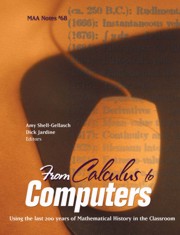Book contents
- Frontmatter
- Preface
- Contents
- Introduction
- I Algebra, Number Theory, Calculus, and Dynamical Systems
- II Geometry
- 6 How to Use History to Clarify Common Confusions in Geometry
- 7 Euler on Cevians
- 8 Modern Geometry after the End of Mathematics
- III Discrete Mathematics, Computer Science, Numerical Methods, Logic, and Statistics
- IV History of Mathematics and Pedagogy
- About the Authors
8 - Modern Geometry after the End of Mathematics
from II - Geometry
- Frontmatter
- Preface
- Contents
- Introduction
- I Algebra, Number Theory, Calculus, and Dynamical Systems
- II Geometry
- 6 How to Use History to Clarify Common Confusions in Geometry
- 7 Euler on Cevians
- 8 Modern Geometry after the End of Mathematics
- III Discrete Mathematics, Computer Science, Numerical Methods, Logic, and Statistics
- IV History of Mathematics and Pedagogy
- About the Authors
Summary
It appears to me also that the mine [of mathematics] is already very deep and that unless one discovers new veins it will be necessary sooner or later to abandon it. Physics and chemistry now offer the most brilliant riches and easier exploitation; also our century's taste appears to be entirely in this direction and it is not impossible that the chairs of geometry in the Academy will one day become what the chairs of Arabic presently are in the universities.
—Lagrange, September 21, 1781 [5]Introduction
In Mathematical Thought from Ancient to Modern Times, Morris Kline writes “By the end of the eighteenth century … the mathematicians began to feel blocked.” [5] Several prominent mathematicians expressed concern regarding the future of mathematics. Lagrange fears the end of mathematical evolution, writing that perhaps “it will be necessary sooner or later to abandon it.” Kline continues: “Euler and d'Alembert agreed with Lagrange that mathematics had almost exhausted its ideas, and they saw no new great minds on the horizon.” As final evidence of his assertions, he includes thoughts from both Diderot and Delambre.
I dare say that in less than a century we shall not have three great geometers left in Europe. This science will very soon come to a standstill where the Bernoullis, Maupertuis, Clairauts, Fon-taines, d'Alemberts and Lagranges will have left it. … We shall not go beyond this point.
— Diderot, 1754 [5]- Type
- Chapter
- Information
- From Calculus to ComputersUsing the Last 200 Years of Mathematics History in the Classroom, pp. 93 - 98Publisher: Mathematical Association of AmericaPrint publication year: 2005



